Updated: AOpen MiniPC – Imitation is the Sincerest Form of Flattery
by Jarred Walton on March 3, 2006 12:05 AM EST- Posted in
- Systems
Power Usage and Noise Levels
Power and noise levels were tested at both idle (sitting at the Windows desktop) and load situations. For the loaded configurations, we recorded the maximum noise and power levels while encoding The Sum of All Fears to DivX/Xvid. This put the CPU at 100% load for about 10 to 15 minutes, and we measured near the end of that time to get the worst case values. The noise level was measured at a distance of one foot and four feet, with the latter being the more important score in our opinion. Few people have their PC within a foot of their ears, after all.
The ambient noise level was below 30 dB, at which point our SPL meter loses any real accuracy. We recorded a minimum score of 30 dB in cases where the SPL couldn't get a clear reading. While 30 dB is still audible, with our testing tools it can be considered near-silent. Without a completely sound-proof testing chamber and more sensitive equipment, we cannot quantify noise levels below 30 dB. Also note that in most homes and offices the background noise level will equal or surpass that 30 dB. Put another way, 30 dB represents the best score that we can currently get.
Testing was conducted with the computer system sitting on a desk approximately 2 feet away from a wall. This is in contrast to the way that many manufacturers conduct noise testing, where the system is placed on a table in the middle of a large room. Realistically, we feel that nearly everyone will have their computer on a desk near some wall, and sound will reflect off the walls potentially increasing the noise levels. We are more interested in real-world testing then in theoretical scenarios. That is why we also skip artificial "maximum noise" tests where the fans are set to full speed in the BIOS. The MZ855 does have the potential to be louder in such a scenario, as do some of the other systems, but in real-world testing we could not get the noise levels higher than what we have reported here.
As you can see, the MiniPC is relatively quiet, but the small fan inside is definitely not silent. Minimum noise levels are very good, and it's about equal to the best of the units that we've tested. Maximum noise levels are higher than some of the other SFFs, unfortunately. Clearly, a smaller fan spinning at higher RPMs isn't an optimal noise solution, and the larger fans and heat sinks in the other cases help out. Of course, you can't really fit any of the larger fans into the MiniPC without increasing its size, and 36 dB really isn't that loud. The volume of the fans also fluctuated between 33 and 36 dB at 100% load, so the worst case score is not actually a constant noise pollutant.
The "typical desktop" system is represented by the ASUS Sempron unit, which was installed in an Antec SLK-1650 case with one 120mm rear fan and an additional 80mm front fan. That system has a relatively constant noise output, and it's about 1.5 times as loud, given the 4-5 dB difference. Personally, I wouldn't want anything more than 35 dB (at 48 inches) in a system that's supposed to be quiet; the MiniPC is right on the edge of that limit under load, but if your system will normally sit idle, it certainly isn't obtrusive.
Update: We mentioned earlier that the fan in our system failed after we had just finished testing. AOpen sent us a new fan and asked us to reconduct the noise tests. We have obliged, and though the final results aren't drastically different, noise levels do drop somewhat. Under full load, the system is between 1-1.5 dB quieter. At idle, noise levels have dropped to the point where our equipment loses sensitivity. At 12 inches, the system is barely audible above the room noise, so the 31 dB score is more or less accurate. Of course, unless you run some application(s) to keep the CPU under constant high load, you will usually have the system at near-inaudible levels. For office use, that's the most likely scenario, and the MiniPC does very well.
System Power Usage
Power draw was measured at the outlet, so the PSU used in each system will have an impact depending on its efficiency. While we would have liked to test out power saving features on all the systems, the current BIOS of the MiniPC lacks that option, as do some of the other systems. We did enable Cool 'n Quiet on the HP DX5150 for this test, and you can see that the minimum power draw dropped by 10W relative to our initial benchmarks with CnQ disabled. Frankly, a 10W difference isn't that huge, and anything under 100W ends up costing about as much to run as a light bulb.
It's true, dropping the CPU speed from 2.0 GHz to 600 MHz will use less power. However, keep in mind that even a 100W reduction in power draw works out to $5-$7 per month for a system that is on 24/7. If the difference between idle at full speed and idle at 1/3 speed is only 10-20W, the savings on your power bill really don't amount to much. A big business running thousands of PCs might notice some savings, but any place running thousands of PCs is likely running tens or hundreds of thousands of lights, not to mention other equipment. If power draw is important to you, though, the MiniPC is really going to impress.
The strong point of the MiniPC is obviously going to be power requirements. The Pentium M and other laptop components work well in a low power environment. The Sempron and Athlon 64 parts also do well, but they can't quite match the Pentium M at idle, and at load, they consume over twice as much power. Of course, they're also faster, and having larger motherboards with more features, more RAM, and faster 3.5" 7200 RPM hard drives all contribute to additional power requirements. NetBurst-based systems are in an even higher class when it comes to power and heat, and there's a reason we're not particularly keen on recommending any of the current socket 775 SFFs on the market. You're better off going with AMD socket 939 SFFs right now, or if you really want low power, you can go with one of the Pentium M platforms. End of discussion.
Power and noise levels were tested at both idle (sitting at the Windows desktop) and load situations. For the loaded configurations, we recorded the maximum noise and power levels while encoding The Sum of All Fears to DivX/Xvid. This put the CPU at 100% load for about 10 to 15 minutes, and we measured near the end of that time to get the worst case values. The noise level was measured at a distance of one foot and four feet, with the latter being the more important score in our opinion. Few people have their PC within a foot of their ears, after all.
The ambient noise level was below 30 dB, at which point our SPL meter loses any real accuracy. We recorded a minimum score of 30 dB in cases where the SPL couldn't get a clear reading. While 30 dB is still audible, with our testing tools it can be considered near-silent. Without a completely sound-proof testing chamber and more sensitive equipment, we cannot quantify noise levels below 30 dB. Also note that in most homes and offices the background noise level will equal or surpass that 30 dB. Put another way, 30 dB represents the best score that we can currently get.
Testing was conducted with the computer system sitting on a desk approximately 2 feet away from a wall. This is in contrast to the way that many manufacturers conduct noise testing, where the system is placed on a table in the middle of a large room. Realistically, we feel that nearly everyone will have their computer on a desk near some wall, and sound will reflect off the walls potentially increasing the noise levels. We are more interested in real-world testing then in theoretical scenarios. That is why we also skip artificial "maximum noise" tests where the fans are set to full speed in the BIOS. The MZ855 does have the potential to be louder in such a scenario, as do some of the other systems, but in real-world testing we could not get the noise levels higher than what we have reported here.
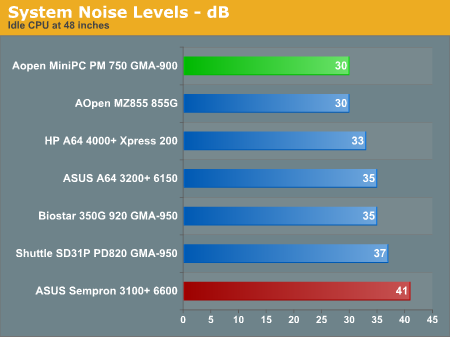
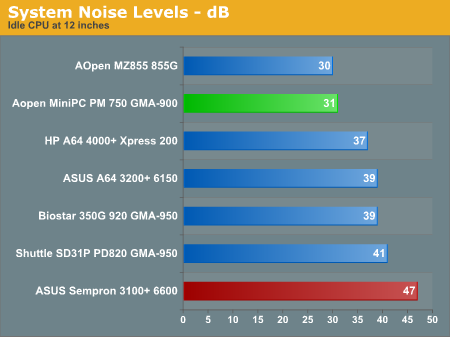
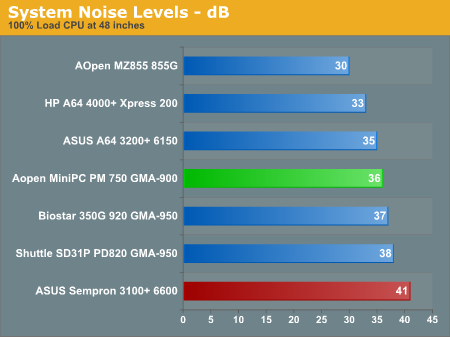
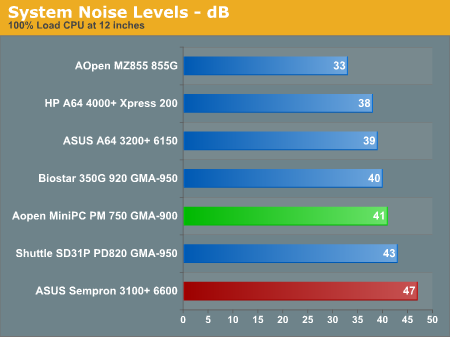
As you can see, the MiniPC is relatively quiet, but the small fan inside is definitely not silent. Minimum noise levels are very good, and it's about equal to the best of the units that we've tested. Maximum noise levels are higher than some of the other SFFs, unfortunately. Clearly, a smaller fan spinning at higher RPMs isn't an optimal noise solution, and the larger fans and heat sinks in the other cases help out. Of course, you can't really fit any of the larger fans into the MiniPC without increasing its size, and 36 dB really isn't that loud. The volume of the fans also fluctuated between 33 and 36 dB at 100% load, so the worst case score is not actually a constant noise pollutant.
The "typical desktop" system is represented by the ASUS Sempron unit, which was installed in an Antec SLK-1650 case with one 120mm rear fan and an additional 80mm front fan. That system has a relatively constant noise output, and it's about 1.5 times as loud, given the 4-5 dB difference. Personally, I wouldn't want anything more than 35 dB (at 48 inches) in a system that's supposed to be quiet; the MiniPC is right on the edge of that limit under load, but if your system will normally sit idle, it certainly isn't obtrusive.
Update: We mentioned earlier that the fan in our system failed after we had just finished testing. AOpen sent us a new fan and asked us to reconduct the noise tests. We have obliged, and though the final results aren't drastically different, noise levels do drop somewhat. Under full load, the system is between 1-1.5 dB quieter. At idle, noise levels have dropped to the point where our equipment loses sensitivity. At 12 inches, the system is barely audible above the room noise, so the 31 dB score is more or less accurate. Of course, unless you run some application(s) to keep the CPU under constant high load, you will usually have the system at near-inaudible levels. For office use, that's the most likely scenario, and the MiniPC does very well.
System Power Usage
Power draw was measured at the outlet, so the PSU used in each system will have an impact depending on its efficiency. While we would have liked to test out power saving features on all the systems, the current BIOS of the MiniPC lacks that option, as do some of the other systems. We did enable Cool 'n Quiet on the HP DX5150 for this test, and you can see that the minimum power draw dropped by 10W relative to our initial benchmarks with CnQ disabled. Frankly, a 10W difference isn't that huge, and anything under 100W ends up costing about as much to run as a light bulb.
It's true, dropping the CPU speed from 2.0 GHz to 600 MHz will use less power. However, keep in mind that even a 100W reduction in power draw works out to $5-$7 per month for a system that is on 24/7. If the difference between idle at full speed and idle at 1/3 speed is only 10-20W, the savings on your power bill really don't amount to much. A big business running thousands of PCs might notice some savings, but any place running thousands of PCs is likely running tens or hundreds of thousands of lights, not to mention other equipment. If power draw is important to you, though, the MiniPC is really going to impress.
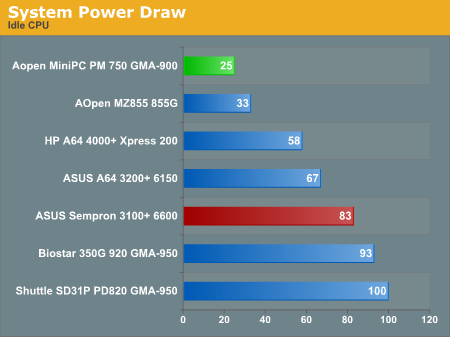
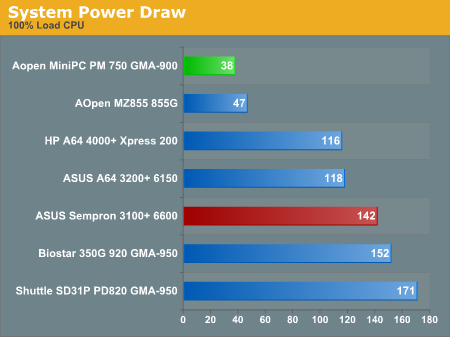
The strong point of the MiniPC is obviously going to be power requirements. The Pentium M and other laptop components work well in a low power environment. The Sempron and Athlon 64 parts also do well, but they can't quite match the Pentium M at idle, and at load, they consume over twice as much power. Of course, they're also faster, and having larger motherboards with more features, more RAM, and faster 3.5" 7200 RPM hard drives all contribute to additional power requirements. NetBurst-based systems are in an even higher class when it comes to power and heat, and there's a reason we're not particularly keen on recommending any of the current socket 775 SFFs on the market. You're better off going with AMD socket 939 SFFs right now, or if you really want low power, you can go with one of the Pentium M platforms. End of discussion.










54 Comments
View All Comments
plinden - Friday, March 3, 2006 - link
Yeah, when are we getting the ability to edit our posts?siliconthoughts - Friday, March 3, 2006 - link
When a genuine mac mini costs less, is more upgradeable (dual core, 2 DDR slots, digital audio, WiFi, Bluetooth, 4 USB ports, faster graphics) comes with a nifty secure OS and includes a whole suite of apps, why would anyone buy this? XP just isn't that great that I'd spend a $300 premium for it on an inferior box.Googer - Friday, March 3, 2006 - link
These are nice, but It is my suspicion that a Turon in an Mini PC would be the faster choice.NegativeEntropy - Saturday, March 4, 2006 - link
Agreed -- a Turion "version" would be interesting. That said, I think this statement from the review could use a bit of modifying:"...if you really want low power, you can go with one of the Pentium M platforms. End of discussion. "Tech Report recently found that the Turion can compete pretty well with the PM on power consumption http://techreport.com/reviews/2006q1/pentiumm-vs-t...">http://techreport.com/reviews/2006q1/pentiumm-vs-t...
JarredWalton - Saturday, March 4, 2006 - link
This isn't meant as a far-reaching statement. What I'm talking about is small form factors, or systems that will compete with the MiniPC. Turion support on socket 754 platforms is lacking, meaning that there are boards that support it but there are definitely boards that won't support it. Most of the socket 754 small form factors are pretty old, so I don't know how many of them would support Turion.The article at Tech Report is interesting, but idle power draw is only half of the question. 94 W at full load really isn't that much better than the rest of the Athlon 64 line. I mean, the HP DX5150 with an old ClawHammer core running at 2.4 GHz is only about 20 W higher. If you were to use a 90 nm Athlon 64, that would cut off 10 W or so right there.
Basically, the Athlon 64 design is really good, and it doesn't require all that much power. However, it still can't really compete with the Pentium M. when you shift to laptops, the whole system probably doesn't consume more than 45 W, so 20 W more for the processor is a major deal. Using desktop systems to try and determine laptop suitability is definitely not the best way to go about it. Ideally, you would want identical laptops, with the only difference being motherboard, chipset, and memory. But that's a story for another day.
Googer - Friday, March 3, 2006 - link
I would love to see this Aopen MINI PC rebench marked with a Pentium M 733 or 753 Ultra Low Voltage Processor that has a Maximum of 5W TDP! I would love to see it compaired against the higher 27W TDP Pentium M 740 in both Power Consumtion and Application benchmarks.I bet that at full load the power usage on full load will drop from 38W (with 740) down to 16w and even lower at IDLE! (10W maybe?) With a processor like that this would be the perfect pc for those guys who like to intergrate computers with their cars. Bye bye VIA C3! (C3 Will have http://www.metku.net/index.html?sect=view&n=1&...">other uses though)
JarredWalton - Friday, March 3, 2006 - link
Actually, with the HDD and other components, the system is probably using around 18W for the system and 7 to 20W for the CPU. It might even be 20-22W for the system. Still, 38W at maximum load (i.e. HDD activity along with 100% CPU) is hardly going to tax a car, I don't think. (But I'm not a car A/V guy, so maybe I'm wrong.)michael2k - Friday, March 3, 2006 - link
You would think, with AOpen's resources, that the AOpen MiniPC would be cheaper than the more powerful and featureful Mac mini.What is AOpen doing that is making it more expensive? It's got an older chipset, slower CPU, less USB ports, no rewritable optical drive, no bluetooth, and no wireless networking.
It's an odd day when buying a Mac is cheaper AND more powerful.
Questar - Friday, March 3, 2006 - link
AOpen isn't isn't a computer manufacturer, they are a board maker. What could they do to bring down the price of a system?jconan - Friday, March 3, 2006 - link
It's the economy of scale! Apple definitely has this contract manufacturing capacity considering its hardware/software business as well as its distribution channels. AOpen is just a manufacturing firm and is not in the software business to install an in house OS and plus it doesn't have sufficient sales offices out in the distribution side to push its wares. They have to rely on major OEMs to buy in bulk quantity to leverage prices with them.